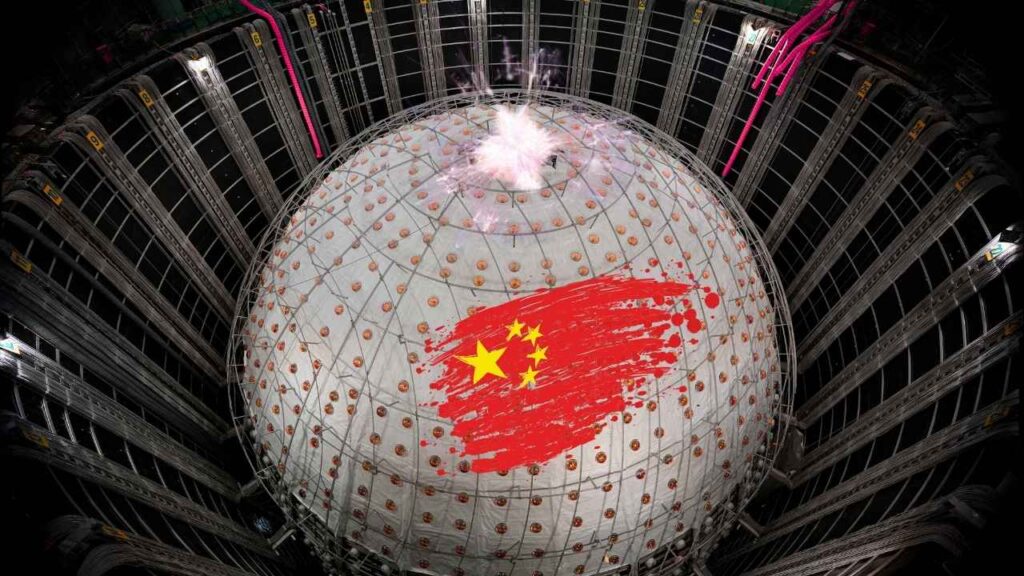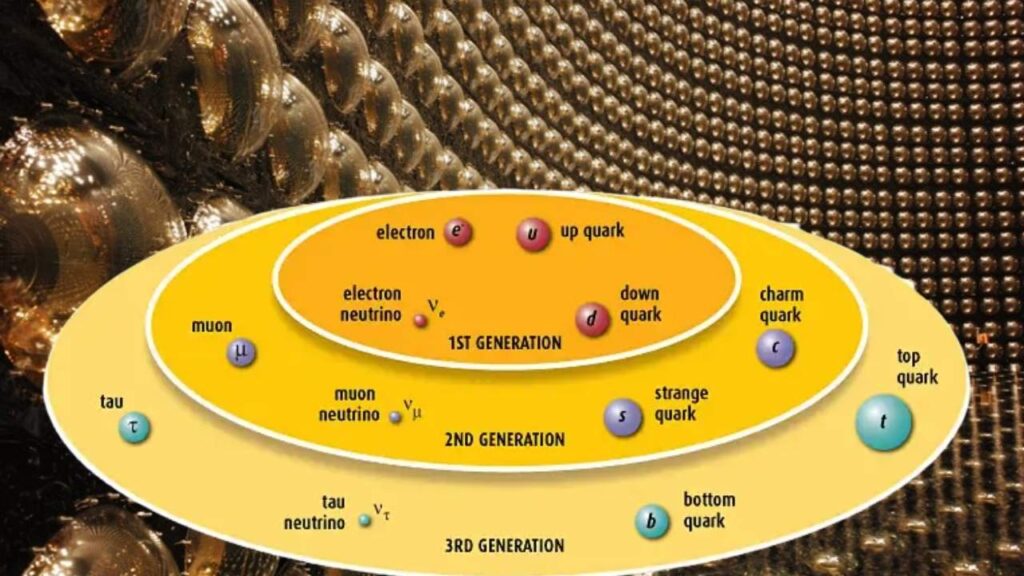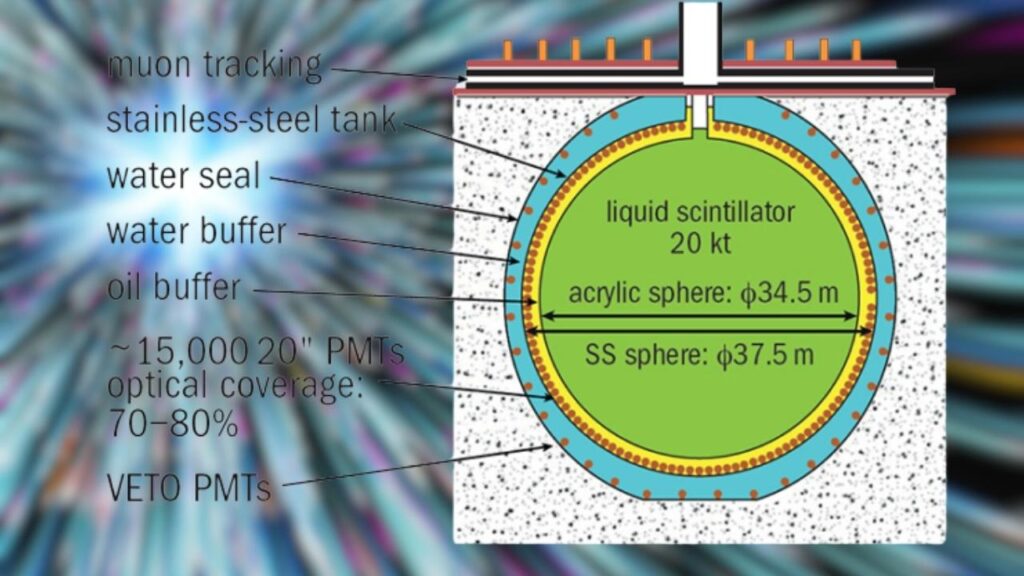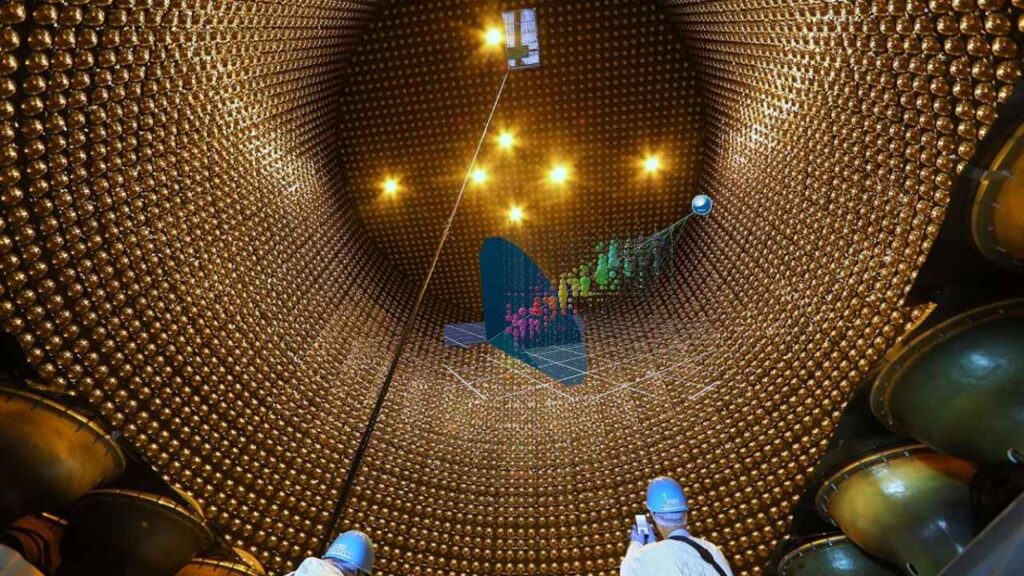China’s JUNO Neutrino Observatory: The Jiangmen Underground Neutrino Observatory (JUNO), located in southern China’s Guangdong Province, is rapidly advancing toward full operational status, expected by August 2025. As one of the world’s largest and most sophisticated neutrino experiments, JUNO represents a major milestone in particle physics, astrophysics, and Earth sciences. Its advanced design and strategic location enable unprecedented precision in studying neutrinos—some of the universe’s most elusive and intriguing fundamental particles.

This article provides an in-depth look into JUNO’s scientific goals, technological innovations, operational principles, and the broader impact of its anticipated discoveries. Designed to be understandable for general readers while offering comprehensive details useful for professionals, this guide highlights JUNO’s critical role in advancing global neutrino research.
The Jiangmen Underground Neutrino Observatory is set to become a centerpiece of global neutrino research by August 2025. Its groundbreaking scale, technological sophistication, and strategic design will allow it to unravel the mysteries of neutrino masses and oscillations with unprecedented precision. The insights from JUNO will deepen our understanding of particle physics, astrophysics, and Earth sciences, marking a significant leap forward in humanity’s quest to comprehend the fundamental workings of the universe.
Table of Contents
Understanding Neutrinos: The Tiny Particles with Huge Implications
What Are Neutrinos?

Neutrinos are fundamental particles belonging to the lepton family, sharing the particle zoo with electrons but distinguished by their neutral electric charge and extremely small mass. They interact only via the weak nuclear force and gravity, making them notoriously difficult to detect. These ghostly particles stream through the universe in astronomical quantities, generated in nuclear reactions in the Sun, stars, supernovae, cosmic rays, and man-made nuclear reactors.
Every second, about 100 billion neutrinos pass through each square centimeter of your body without leaving a trace. Despite this, studying neutrinos is crucial because they carry unique information about processes inside the Sun, the Earth’s core, and distant cosmic events unreachable by other means.
Why Is Neutrino Research Important?
Neutrinos are key to understanding:
- The Fundamental Structure of Matter: Neutrinos challenge the Standard Model of particle physics. Their small, nonzero masses and ability to oscillate between flavors imply physics beyond the Standard Model, potentially revealing new particles or interactions.
- The Neutrino Mass Hierarchy: Scientists want to know the exact ordering of neutrino masses—whether it follows a “normal” or “inverted” hierarchy. Resolving this will help refine models of particle physics and cosmology.
- The Origins of the Universe: Neutrinos played a role in the early universe’s evolution, influencing the formation of galaxies and cosmic structures.
- Astrophysical Processes: Neutrinos from supernovae and other cosmic phenomena carry information that photons cannot provide, giving insights into star explosions and the formation of heavy elements.
- Geosciences: Studying geoneutrinos emitted from radioactive decays inside the Earth helps understand the planet’s heat production and internal composition.
JUNO’s Scientific Objectives: Precision and Breadth
JUNO’s primary scientific mission is to determine the neutrino mass hierarchy by measuring reactor antineutrinos with exquisite precision. Unlike previous detectors, JUNO combines massive detector volume and state-of-the-art technology to achieve an unprecedented energy resolution of 3% at 1 MeV (million electron volts), crucial for distinguishing subtle differences in neutrino oscillation patterns.
Other important goals include:
- Measuring the parameters of neutrino oscillations (mixing angles and mass differences) with accuracy better than 1%.
- Detecting neutrinos emitted by the Sun to probe solar fusion reactions and test solar models.
- Observing neutrinos produced by cosmic rays interacting with the atmosphere.
- Detecting geoneutrinos from radioactive decays in the Earth’s crust and mantle.
- Acting as a supernova neutrino observatory, ready to detect bursts of neutrinos emitted during a nearby star explosion, providing an early alert system.
The JUNO Detector: Engineering Marvel and Scientific Instrument

Location and Underground Facility
JUNO is situated about 700 meters (2,300 feet) underground in a mountain near Jiangmen city to minimize background noise from cosmic rays, which can interfere with delicate neutrino measurements. The underground cavern housing JUNO is approximately 100 meters wide and 170 meters long, built to accommodate the massive detector and supporting infrastructure.
The Central Detector
The centerpiece of JUNO is a 35.4-meter diameter acrylic sphere, one of the largest in the world, filled with 20,000 tons of ultrapure liquid scintillator. This scintillator fluid emits tiny flashes of light (scintillations) when charged particles created by neutrino interactions pass through it.
Photomultiplier Tubes (PMTs)
Surrounding the acrylic sphere are over 43,000 large-area photomultiplier tubes (PMTs)—ultra-sensitive light detectors that convert the scintillation light into electrical signals for analysis. JUNO employs two types of PMTs:
- 20-inch diameter PMTs for high light collection efficiency.
- 3-inch diameter PMTs arranged densely to enhance timing and spatial resolution.
The combination ensures exceptional energy resolution and event reconstruction accuracy.
Calibration Systems and Purity Control
Maintaining the scintillator’s optical clarity and precise calibration is vital. JUNO features sophisticated calibration devices that deploy radioactive sources, lasers, and LEDs inside the detector to monitor response uniformity and stability.
The liquid scintillator is purified to reduce contamination by natural radioactivity, which could create false signals. Continuous purification systems keep the liquid clean throughout the experiment’s lifetime.
Neutrino Detection: How JUNO Sees the Invisible

Reactor Antineutrinos
The primary neutrino source for JUNO is a cluster of nuclear reactors located about 53 kilometers (33 miles) away. These reactors produce a copious flux of electron antineutrinos during nuclear fission. JUNO’s distance is carefully chosen to maximize sensitivity to neutrino oscillations, as neutrinos change flavor in a predictable way over that baseline.
Detection Process
When an antineutrino interacts with a proton in the scintillator, it produces a positron and a neutron in a process called inverse beta decay. The positron quickly annihilates with an electron, creating two photons detected as a prompt light signal. The neutron is captured by a proton a few microseconds later, producing a delayed light signal. This coincidence of prompt and delayed signals helps identify genuine neutrino events and reject background noise.
JUNO’s International Collaboration and Scientific Impact
JUNO is a large-scale international collaboration involving more than 700 scientists from over 80 institutions in 17 countries, including China, the United States, Italy, France, Germany, and others. This diverse team brings expertise from particle physics, engineering, computing, and more.
The data JUNO produces will complement other major neutrino experiments worldwide, such as:
- DUNE (Deep Underground Neutrino Experiment) in the United States.
- Hyper-Kamiokande in Japan.
Together, these experiments will provide a comprehensive picture of neutrino properties and contribute to answering fundamental physics questions.
Broader Implications and Future Prospects
Contributions to Fundamental Physics
JUNO’s results will either confirm or challenge existing theories, potentially pointing toward new physics beyond the Standard Model. Understanding neutrino masses and mixing angles also impacts theories on matter-antimatter asymmetry in the universe, helping explain why matter dominates over antimatter.
Astrophysics and Earth Science
JUNO’s capability to detect neutrinos from supernovae offers a unique window into these rare cosmic events, potentially enabling multi-messenger astronomy by correlating neutrino bursts with electromagnetic and gravitational wave signals.
By detecting geoneutrinos, JUNO contributes to our knowledge of Earth’s interior heat production, complementing seismic and geological studies.
India Launches BharatGen AI Model to Revolutionize Multilingual Innovation at BharatGen Summit
MIT Engineers Develop New 3D Printing Method to Reduce Waste and Enable Complex Designs
Robotic Transfer Technique Enhances Scalability of 2D Materials for Device Integration
FAQs About China’s JUNO Neutrino Observatory
What is the neutrino mass hierarchy, and why does it matter?
The neutrino mass hierarchy refers to the ordering of the three neutrino mass states, which impacts how neutrinos oscillate. Knowing the hierarchy helps refine particle physics models and understand the role neutrinos play in the cosmos.
Why does JUNO need to be underground?
Being deep underground shields the detector from cosmic rays and background radiation that could mimic or obscure neutrino signals, thus enhancing detection accuracy.
How large is JUNO compared to other neutrino detectors?
JUNO is the largest liquid scintillator detector in the world, with a 20,000-ton target mass, surpassing previous detectors like KamLAND (Japan) and Borexino (Italy).
When will JUNO start taking data?
JUNO aims to begin data collection by August 2025, with full scientific operations expected soon thereafter.
Can JUNO detect neutrinos from supernovae?
Yes. JUNO is designed to detect neutrino bursts from nearby supernovae, providing early warnings and detailed data for astrophysical studies.



















